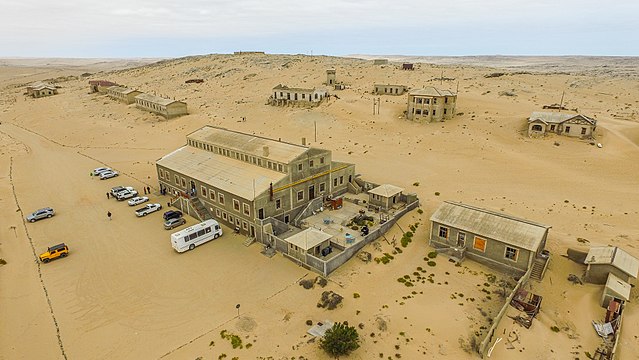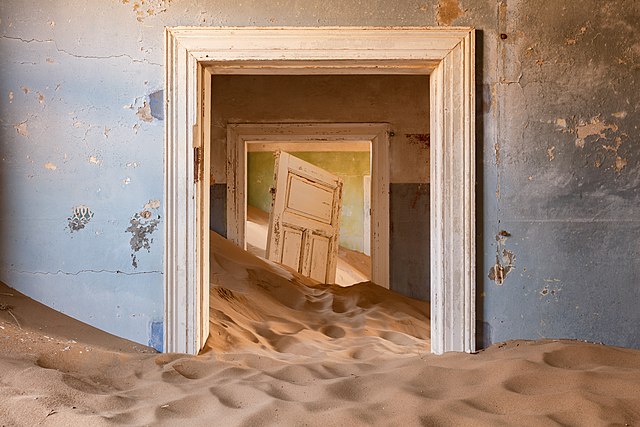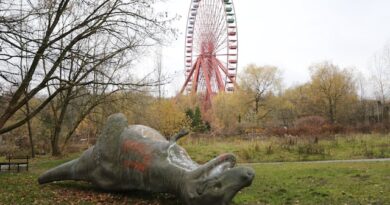Kolmanskop Ghost Town, Created By The Sands Of Time
A few years ago, I saw a horror movie called “The Sand.” As you can deduce from the name of the film and the fact that you probably haven’t heard of it, it tells the story of a bunch of stupid young people who wake up one morning, after a night of debauchery, on the beach. They discover that the sand surrounding them is vegan and monstrous. One by one, they drown, are eaten, or die in strange ways in the sand. Since then, I’ve been trying to suppress this movie, but when I saw the pictures of the ghost town of Kolmanskop in Namibia, which was almost completely taken over by the sand, I couldn’t help but remember this movie.
The story of Kolmanskop ghost town is about a place that was prosperous in the past but was abandoned and let nature take over. This is a town where you will find today only sand and sand. Precisely for these reasons, it has become a fascinating tourist destination.
In The Name Of Diamonds
Kolmanskop is located in the southwestern part of Namibia, a country you’ll find in the southern part of the African continent. It is located in the heart of the Namibian desert (which is the oldest desert in the world, with a history of about 55 million years) and not far from the Skeleton Coast in Namibia, a place already by its name it is clear to us that it will receive an independent review on the website soon. The origin of the term “Colemanskop,” loosely translated, is “Coleman’s head.” The source of the name is a story about a coachman named Johnny Coleman, who provided services there before the railroad was built and encountered a severe sandstorm. The storm made him flee for his life, abandoning his ox wagon. This is not the last time the sand will show its possession of the town.

Kolmanskop’s history began in the 20th century, or rather around 1907. This year, a German man named August Stauch arrived in the town of Lideritz (which is about 15 km away from it). The same Stauch worked as a railway inspector, which connected Lideritz and A town called Aus. He knew there was a good chance of finding diamonds and received a license to go looking for them from the authorities of German Southwest Africa, a colony of the German Empire with a bloody history of violence and genocide. Just a few years before the formation of Kolmenskop, the local natives tried to rebel under German rule. The result was a brutal massacre of over 60,000 natives.
The railway workers labored to locate the diamonds in their free time or between jobs. In April 1908, one of them, Zacharias Lewala, discovered a diamond in the sand and informed Stauch of the find. The latter saw it was a precious diamond but decided not to compensate the dedicated employee. Stauch submitted a letter of resignation (in this period, there was no use of e-mail or WhatsApp messages for such messages), became a mining engineer, and began to search for diamonds independently. They located more diamonds, which led to the declaration of a vast area called “Sperrgebiet” (“The Forbidden Zone”) – which included what would later become Kalmonskop. The Germans, who wanted all the diamonds for themselves, severely restricted entry to the area.
The local trading arena for diamonds was established in 1909. The mining rights were given exclusively to one company, founded in Berlin. In that year, they produced about half a million carats of diamonds and about 1.5 million carats each of the following five years. At that time, over a tenth of the volume of diamond production in the world was done in the small Kolmanskop.

A European Town In The Middle Of The Aftican Desert
Kolmanskop – Namibia was established at the heart of “The Diamond Rush” process. Quite a few houses were built there in style reminiscent of German architecture, and Kolmanskop began to be covered with concrete and tendons. Hundreds of people settled there, most of them German diamond miners or workers in the mining industry. They established institutions that would not embarrass a significant town today. In this small area, you could find a small hospital, a power station, a school, cultural institutions (such as a theater and even a bowling alley), an ice cream factory, a swimming pool, and more. Damn, they even decided to establish a casino here.
All these infrastructures may seem unnecessary in a town, far from being too big. Still, you must remember the location of Kolmanskop, Namibia, in the heart of the desert, and the fact that the settlers sometimes raked in huge sums for the diamonds they found. They were looking for a high quality of life and found it in an almost entirely European town they built, with an apparent western influence.
It wasn’t easy to make a settlement in the heart of a desert, but they did a good job. Residents received free electricity, water (according to quotas), and ice. They founded an industrial area in the town and connected the residential areas with a railway on which carriages with donkeys moved. The residents combined business with pleasure, and the sight of sipping a glass of wine, beer, or champagne in the heart of the desert was not imaginary. The future of Kolmanskop Diamond town looked bright, but the thing about diamonds is that they can eventually fade.
The Diamonds Are Not Shiny Anymore: Why Was Kolmanskop Abandoned?
Kolmanskop’s fate could have been more successful. As happened to countless cities and towns during The Diamond Rush – or diamonds, in this case – it began to lose its power. The diamond quota around Kolmanskop was getting thinner and thinner, and on the other hand, the miners discovered diamonds in nearby, more southern areas. From that point, the road to becoming a ghost town is pretty short. he population of Kolmanskop in Namibia, which peaked at over 1,000 people, kept getting smaller. After the First World War, especially in the 20s and 30s of the last century, the process intensified until it was utterly emptied of residents.
As happens in many other abandoned places, when humans leave the picture, the forces of nature enter it. In the decades that Kolmanskop remained empty, the houses started crumbling. But in this case, nature was not wild trees and bushes, but mostly sand – befitting a residential area in the heart of a desert. Sand covered The houses and public buildings, which could be an excellent location for a horror movie about people stuck in an area with murderous sand. In most cases, the sand reached a height of tens of centimeters, even several meters. He changed the position and shape of furniture, so you can sometimes see a “flying” door, a sunken bed, or a bathtub that seems unrelated to the situation. The window frames changed their shape, and in some buildings, you can see rays of light entering the building at strange angles at certain times, to create a surreal appearance.

eady deserted places. For example, some people said that in the house of that mine manager, several decades after the area was emptied of its inhabitants, pierced skulls of miners who lost their tracks were discovered. Of course, these stories may be intended mainly for tourists, but they may work.
Kolmanskop As A Tourist Destination
Since the 80s of the last century, certain buildings in Kolmanskop have been undergoing restoration, but it is evident that this is done mainly for conservation and tourism purposes. In 2002, a local tourism company called Ghost Town Tours took over the job intending to turn the abandoned, sand-laden town into a sought-after destination.
Colemanscope’s opening figures are optimistic. Kolmanskop ghost town enjoys relative proximity to populated areas of Namibia, so you can reach it relatively quickly. That is if we are already making the not-so-simple journey to Namibia. We must not forget Namibia is not considered an accessible or too touristic destination for the average western tourist.
Today you can visit the museum located in Kolmanskop when the empty houses covered in sand – some of them have undergone conservation, restoration, or reconstruction – have become a paradise for photographers and seekers of surreal sights. Please note that to visit the ghost town of Kolmanskop, one has to obtain a special permit or join in advance an organized tour that departs for a fee. According to the stories, the photographers who come here to take pictures also charge considerable sums. Nevertheless, it works pretty well because it is estimated that around 35,000 people visit Kolmanskop every year.

Kolmanskop In Culture
If the lousy horror film from the first paragraph had been filmed with a Kolmanscope, it might have been better – at least we would have gotten some impressive shots. So is a film called “Blood Beach” from 1980 which presents a pretty similar plot. That movie was filmed in Venice Beach on the west side of Los Angeles, including one of the most famous promenades in the world.
But that doesn’t mean, of course, that there aren’t other films that were actually filmed in Kolmanskop, including even one horror film: “Dust Devil” from 1992, which became a kind of cult film. The film was written and directed by the South African Richard Stanley, whose most familiar film to horror fans is the Alien Invasion’s Color Out Of Space, which is not bad at all, starring Nicolas Cage.
“Dust Devil” is a high and thin air vortex, as we are used to seeing in movies about things that get out of control. In the film, we accompany a guy named Hitch (Richard Barak) who arrives in the deserts of Namibia. The residents suspect him of being the “Sand Devil,” a sinister creature that changes shape and kills people. He meets a woman running away from her husband (Chelsea Field) and discovers that some of the stories about the mysterious figure may be true. Towards the end of the film, the same woman arrives at the Kolmanscope, where the final confrontation with the monstrous creature takes place.
Not only horror films take place in the Kolmanskop ghost town. In 2000, “The King Is Alive” was released, part of the Danish “Example 95” movement founded by directors Lance von Trier and Thomas Vintenberg (which brought us, for example, the excellent “Fasten” or “The Idiots”). Some of the movement’s strict rules include filming in real locations and avoiding using sets, artificial lighting, soundtracks outside the film, and even a tripod.
“The King Is Alive” begins like a typical horror, about a group of tourists who get lost in the Namibian desert. When they are cut off from the world and almost destitute, one of them – a theater director – decides to perform Shakespeare’s “King Lear” in front of an audience made up mostly of dunes. While working on the play, the relationships between the characters begin to become complex, and the boundaries between the play and reality become blurred. It’s not a horror movie, so we only have a little to expand on beyond that.
Quite a few documentaries and TV programs dealing with topics such as abandoned places (but what), the mysteries of nature, and the like have been filmed in Kolmanscope, and it is easy to understand why. The abandoned place also found its place in art. A photograph of a house covered in sand from Colemanscope appears on the cover of “The Slow Rush,” the fourth album by Tame Impala – the excellent Australian psychedelic rock band founded by Kevin Parker. The covers of most of the singles from the album were also shot in the ghost town.
Time will tell if Kolmanskop Namibia will keep its charm and continue attracting everyone looking for unusual sights that tell a complete story. And the hourglass will do its thing, despite the restoration and preservation efforts, so the town will be completely buried under the sand.





